How to make Sourdough Starter
Sourdough starter is about as simple as it comes! Learn to enjoy the simple things with this homemade sourdough starter!

Back to Basics
What is a sourdough starter?
It’s a breath of fresh air to make something remarkable out of 2 common ingredients: water and flour
Sourdough Starter is the key ingredient in any kind of sourdough recipe. It’s a mix of water and flour that when put together in a jar, begins a fermentation process. When the water and flour mix, the enzymes in the flour convert the starch molecules into simple sugar. This kicks off the reproduction process for microorganisms which build up the starter. There are quite a few more pages on the science of this bubbly mix of yeast-laden bread starter but the most important thing for us to know is that it is an open door to so many recipes!
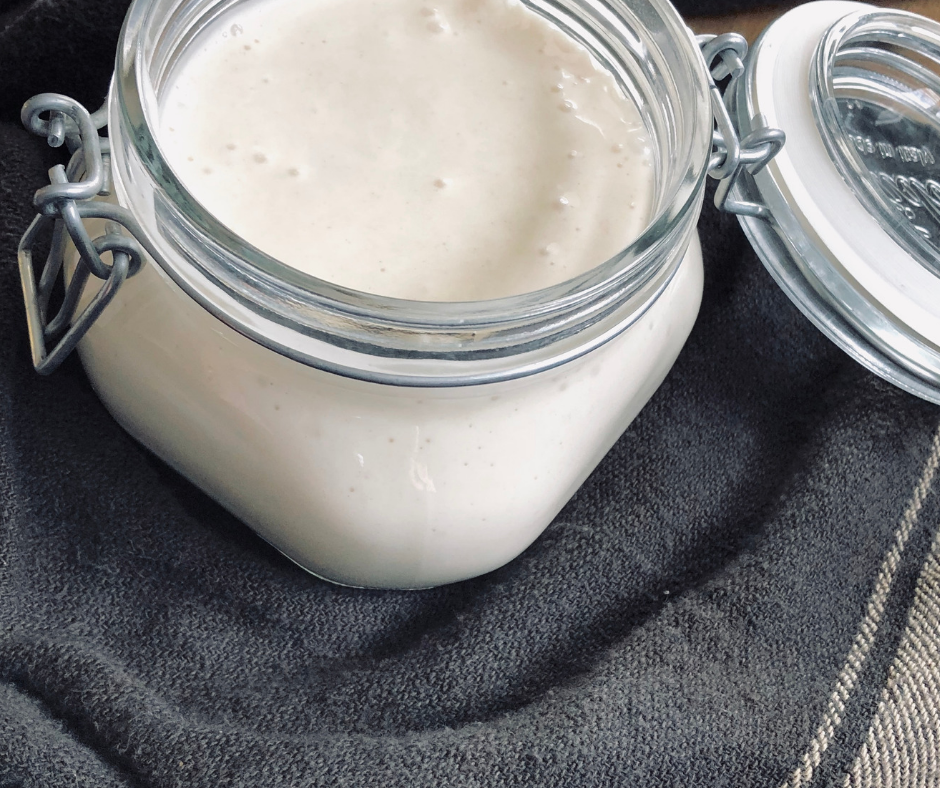
Is Making Sourdough Starter hard?
Nope, not at all, you just have to remember to feed your new little pet for a few days and then, you can keep this puppy as long as you want! The entire process takes about 5 days and after that, you are ready to bake with an active sourdough starter! The taste of your homemade bread or whatever you choose to make out of it will be so, so worth it!
How long will the sourdough starter last and how do I store it?
Some cultures keep bread starter for generations! There are ways to dry it, store it, keep it in the fridge, and bring it out for a recipe periodically, or simply keep it on your counter if you’re going to be doing a bunch of sourdough baking! After the first 5 days of feeding are up, you can continue to feed your starter to keep it fresh and ready to bake for as long as you need. On the other hand, you can also keep it unfed in the fridge. If you are doing this, the jury is still out on the exact time it can stay alive. It could be weeks or months, so my best advice is to get the most out of it while you can and just monitor it for any signs of mold or discoloration.
Why should I make sourdough?
Sourdough is considered a fermented food. Similar to other fermented foods like sauerkraut, kefir, pickles, and kombucha, sourdough bread is fermented by using lactobacillus cultures (a probiotic aka bacteria that benefits your gut). Read more of the science here!
How is sourdough starter used in recipes?
This active starter (aka preferment) can be used to make many delicious foods. In most recipes, you will simply add 1/2 to 1 cup of the starter to your recipe and combine it with the rest of the ingredients. With this easy recipe, you can use your own starter to make fresh sourdough bread, sourdough pretzel bites, sourdough pancakes, sourdough pizza, you name it! Let the science experiment begin!

Are you ready to make your own dough?
Before you start, you may choose to grab my Printable Sourdough Starter Timeline to keep handy in your kitchen.
Sourdough Starter Recipe
TO BEGIN YOUR STARTER
- 1 cup whole-grain flour
- 1/2 cup cool water
TO FEED YOUR STARTER
- 1 cup whole-grain flour
- 1/2 cup cool water (if your house is warm), or lukewarm water (if your house is cool)
Want to skip making your own starter? We’ve got you covered, we can send you some of ours!
INSTRUCTIONS for making your own Sourdough Starter
I found it easier to print out these instructions and tape them to my cupboard as I prepared this starter. These instructions for for keeping a wet or dry starter.
Day 1:
On the first day, combine the flour with the cool water in a non-reactive container. Glass, crockery, stainless steel, or food-grade plastic all work fine for this. Make sure the container is large enough to hold your starter as it grows; at least 1-quart capacity.
Stir everything together thoroughly; make sure there’s no dry flour anywhere. Cover the container loosely and let the mixture sit at warm room temperature (about 70°F) for 24 hours. See below, for advice about growing starters in a cold house.
Day 2:
You may see no activity at all in the first 24 hours, or you may see a bit of growth or bubbling. Either way, discard half of the starter (4 ounces, about 1/2 cup), and add to the remainder 1 cup flour, and 1/2 cup cool water (if your house is warm); or lukewarm water (if it’s cold).
Mix well, cover, and let the mixture rest at room temperature for 24 hours.
Day 3:
By the third day, you’ll likely see some activity — bubbling; a fresh, fruity aroma, and some evidence of expansion. It’s now time to begin two feedings daily, as evenly spaced as your schedule allows. For each feeding, keep 1 cup of starter. Discard any remaining starter. Or you can use this otherwise discarded starter to make pretzels! (See below to how to sign up for my FREE EBook of 5 Tasty Sourdough Starter Recipes)
Add 1 cup (4 ounces) flour, and 1/2 cup water to the 4 ounces starter. Mix the starter, flour, and water, cover, and let the mixture rest at room temperature for approximately 12 hours before repeating.
Day 4:
Keep 1 cup of the Starter and add 1 cup of flour and 1/2 c of water, stir vigorously. Do this twice in the day. Approximately 12 hours apart.
Day 5:
Keep 1 cup of starter, and discard any remaining starter. Add 1 cup of flour and 1/2 c of water, stir vigorously. Do this twice in the day. Approximately 12 hours apart.
By the end of day #5, the starter should have at least doubled in volume. You’ll see lots of bubbles. If your starter hasn’t risen much and isn’t showing lots of bubbles, repeat discarding and feeding every 12 hours on day 6, and day 7, if necessary — as long as it takes to create a vigorous (risen, bubbly) starter.
Once the starter is ready, give it one last feeding. Discard all but 1 cup. Feed as usual. Let the starter rest at room temperature for 6 to 8 hours; it should be active, with bubbles breaking the surface. Hate discarding so much starter? Share a cup with a friend so they can start their very own sourdough starter!
Remove however much starter you need for your recipe — typically no more than 2 cups. If your recipe calls for more than 1 cup of starter, give it a couple of feedings without discarding, until you’ve made enough for your recipe plus 4 ounces to keep and feed again.
Transfer the remaining 1 cup of starter to its permanent home: a glass jar, or whatever you’d like to store it in long-term. Feed this reserved starter with 1 cup of flour and 1/2 cup water, and let it rest at room temperature for several hours, to get going, before covering it. If you’re storing a starter in a screw-top jar, screw the top on loosely rather than airtight. These are my favorite jars. They get used for our Sourdough Starter, my favorite Avocado Oil Mayo, Homemade Hot Cocoa, Russian Tea, Vanilla Chai Tea Latte and pretty much anything else!
Store the starter in the refrigerator, and feed it regularly; I recommend feeding it with 1 cup flour and 1/2 cup water once a week.
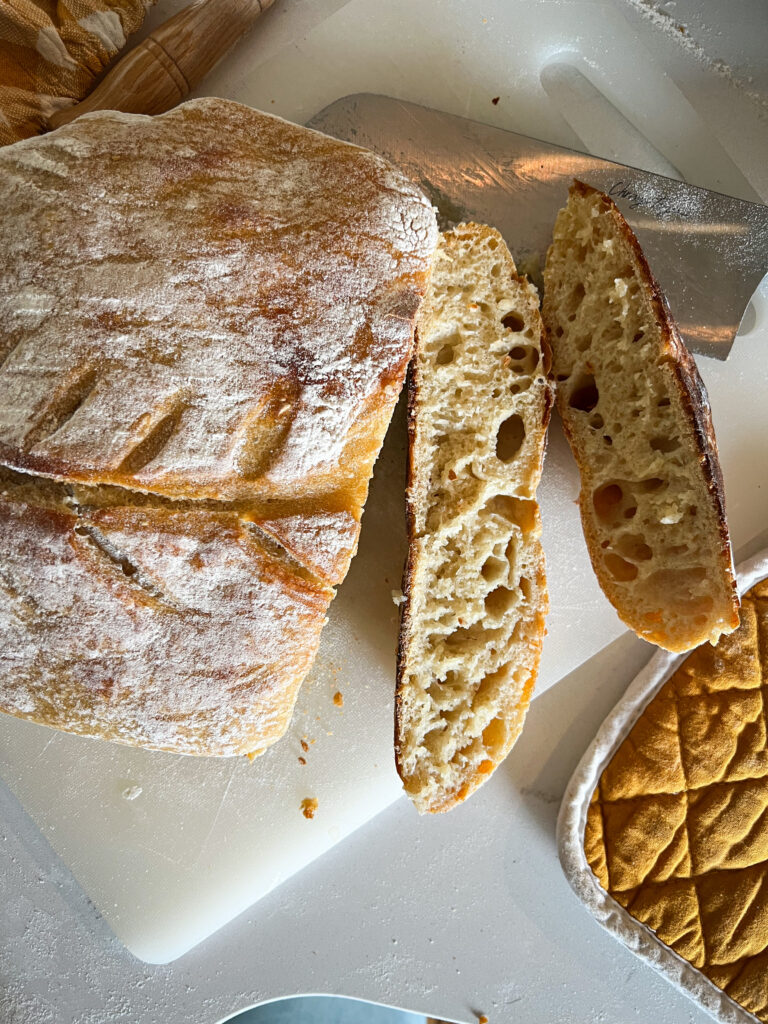
A note about room temperature
the colder the environment, the more slowly your starter will grow. If the normal temperature in your home is below 68°F, we suggest finding a smaller, warmer spot to develop your starter. For instance, try finding a warm spot to set the starter like atop your water heater, refrigerator, or another appliance that might generate ambient heat. I use my turned-off oven — with the light turned on.
Tips for making your own Sourdough Starter
- The Float Test. The 5 – 7 days is the golden time when your starter should be ready. You will know it is ready because of the volume (your jar will have doubled in size) and the appearance (it will have a lot of bubbles). However, maybe this is your first time or you just want to be extra, extra sure it is ready to bake – after all, you didn’t put in those 5 days for nothing! Enter the float test. You can take 1 tsp of your starter and drop it into 1 cup of room-temperature water. If the starter floats, it is a sign it is ready to bake. *Disclaimer: This wouldn’t be a true sourdough blog post if I didn’t mention the float test but it’s important to note that it isn’t always the most reliable. Some whole wheat flours can be so dense that they don’t float
- Volume Tracking. To accurately track how much your starter is growing, you can put a rubber band or piece of tape at the top of your starter. This is a sure way to see how much your starter has grown. Move accordingly each day.
- Temperature. The temperature of your house or where you place your jar of starter does have an impact. If it’s not rising as fast it’s likely because it’s in a colder environment – this doesn’t mean there’s anything wrong, it just might need a couple more days to rise. Relax and stick to the correct flour and water instructions.
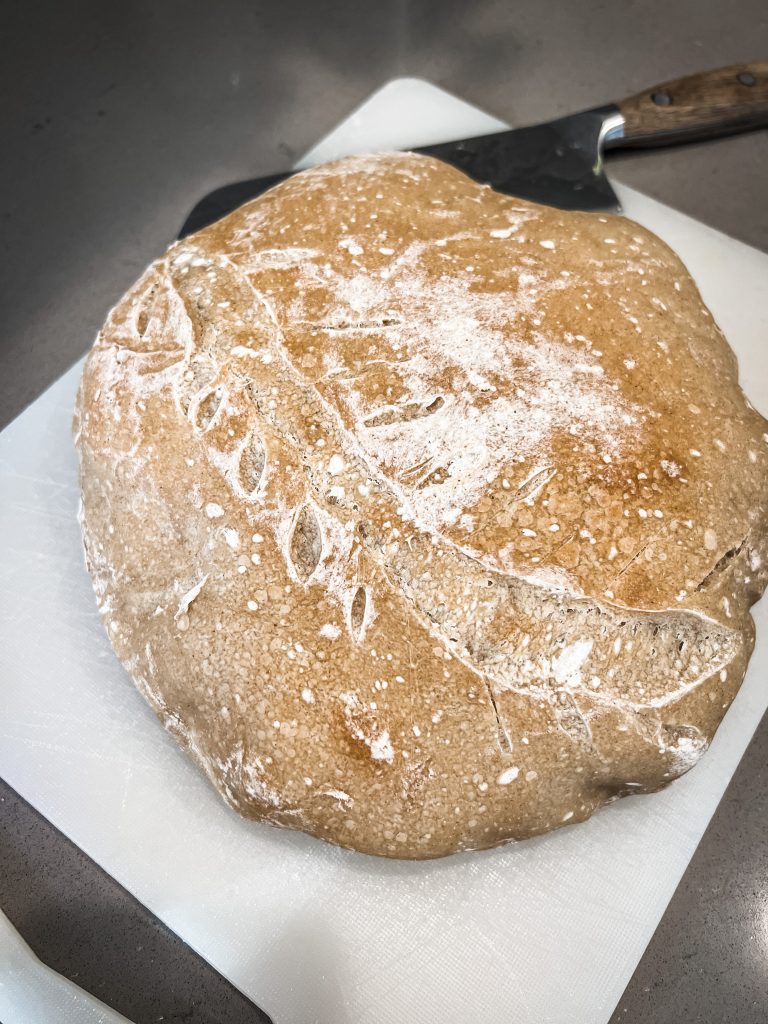
Frequently Asked Questions about making Sourdough Starters
| Should you use bottled or tap water in a sourdough starter? Unless your tap water is so heavily treated that you can smell the chemicals, there’s no need to use bottled water; filtered water from your tap is fine. |
| What flour should I use for Sourdough? Each type of flour will slightly change the flavor and look of your bread. We use whole grain flour because it contains more nutrients and is known to have a faster fermentation process. Other flours you could use include whole wheat flour, rye flour, or white flour. No matter the type of flour, the amount of flour and water used will remain the same. Is Sourdough Starter gluten-free? Not inherently, no, because of the flour. However, it is possible to use gluten free flour – the measurements for the flour to water ratio stay the same and you are on your way to making gluten free bread! |
| Why do you need to discard half of the sourdough starter? It seems so wasteful… But unless you discard the starter at some point, eventually you’ll end up with a very large container of starter. Also, keeping the volume down offers the yeast more food to eat each time you feed it; it’s not fighting with quite so many other little yeast cells to get enough to eat. Most recipes that use a sourdough starter will use 1 cup of it which is the amount you will end up with. You don’t have to actually discard it if you don’t want to, either; you can give it to a friend, or use it to bake. Find a delectable pretzel recipe in my FREE E-book! Sign up to receive my FREE Ebook with “5 Tasty Sourdough Recipes” |
| What flour should I use for Sourdough? Each type of flour will slightly change the flavor and look of your bread. We use whole grain flour because it contains more nutrients and is known to have a faster fermentation process. Other flours you could use include whole wheat flour, rye flour, or white flour. No matter the type of flour, the amount of flour and water used will remain the same. Is Sourdough Starter gluten-free? Not inherently, no, because of the flour. However, it is possible to use gluten-free flour – the measurements for the flour-to-water ratio stay the same and you are on your way to making gluten-free bread! |
Shop all our favorite Sourdough Making Supplies, here!
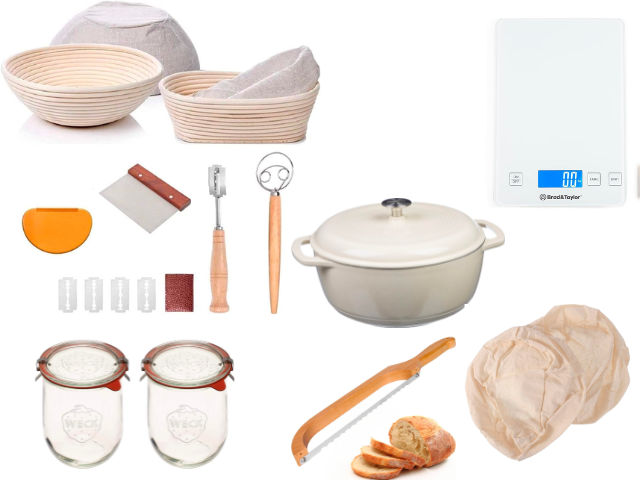
Grab our family’s five favorite sourdough recipe book to get started with your sourdough starter HERE
Do you already have an established sourdough starter? What’s your favorite recipe? Comment below!
As always, feel free to share this post with your friends, if you think they might also be interested in making sourdough starter!
Cheers!

Affiliate Disclosure & Content Disclaimer
This post may contain affiliate links from a paid sponsor, Amazon or other program. When you use these links to make a purchase I earn a small commission at no extra cost to you. This allows me to continue creating the content that you love. The content in this article is created for information only and based on my research and/or opinion.
Emily T.
DAILY INSPIRATION ON THE GRAM @hearty.sol
it's hip to be square!
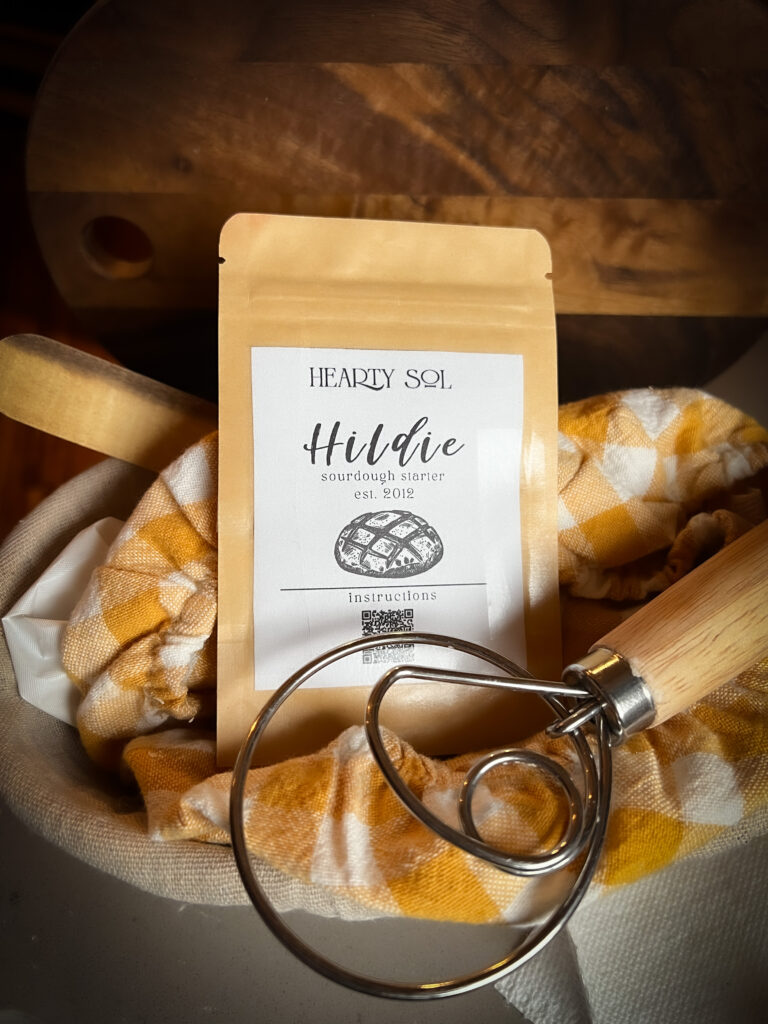

View comments
+ Leave a comment